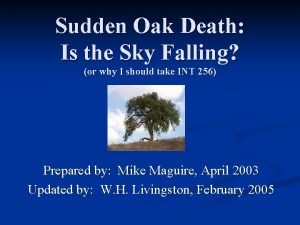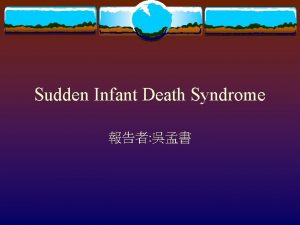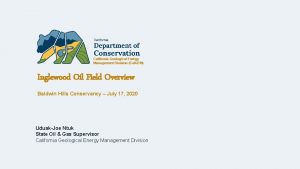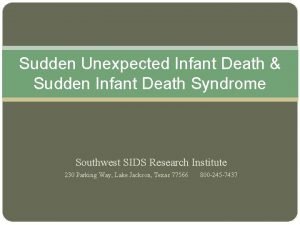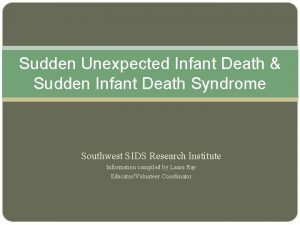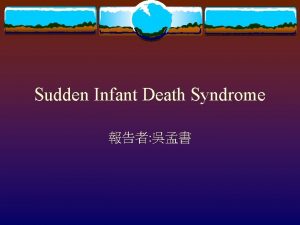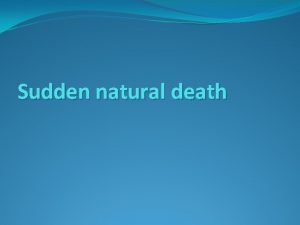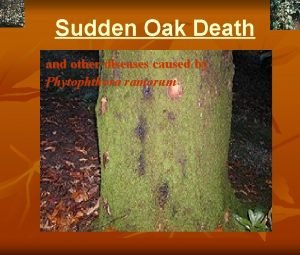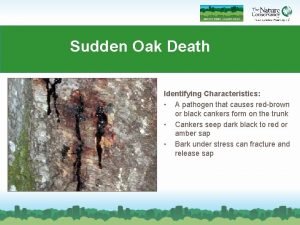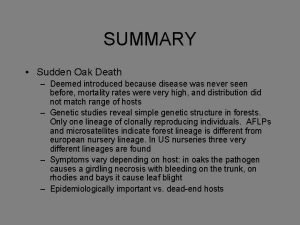Sudden Oak Death California Department of Food and











- Slides: 11

Sudden Oak Death California Department of Food and Agriculture

Phytophthora ramorum - SOD • Caused by the fungus-like organism Phytophthora ramorum. • First identified in 1993 in Germany and the Netherlands on Rhododendron and Viburnum. • 1995 - a new disease killing tanoak and oak trees was observed in California. In 2000, the pathogen was confirmed to be P. ramorum. • Natural infections limited to Europe, California and a small portion of Oregon. • Problem in plant nurseries!

Sudden Oak Death • Related to Phytophthora infestans, the causal agent of late blight of potato • Soil-borne organism, which can cause root, canker, and above-ground infections. • Spread by soil and water splash (irrigation, rain, wind-blown rain…). • Favored by relatively cool temperatures (68 F) and high moisture.

SOD - Hosts • Coast Live Oak (Quercus agrifolia) • Tanoak (Lithocarpus densiflorus) • Shreve’s Oak (Quercus parvula v. • Canyon Live Oak (Quercus • Bigleaf Maple (Acer macrophyllum) • Madrone (Arbutus menziesii) • Manzanita (Arctostaphylos • Coast Redwood (Sequoia • shrevei) manzanita) chrysolepis) sempervirens) • Douglas-Fir (Pseudotsuga menziesii) • Wood Rose (Rosa gymnocarpa) • California Buckeye (Aesculus californica) • • Camellia Pieris Rhododendron & Azalea Viburnum California Bay Laurel (Umbellularia californica) • California Honeysuckle (Lonicera hispidula)

SOD- Associated Hosts • Grand Fir (Abies grandis) • Horse-Chestnut (Aesculus hippocastanum) • Strawberry Tree (Arbutus unedo) • Mountain Laurel (Kalmia latifolia) • Victorian Box (Pittosporum undulatum) • Southern Red Oak (Quercus falcata) • Northern Red Oak (Quercus rubus) • Poison Oak (Toxicodendron diversiloba) • European Yew (Taxus baccata) • Lilac (Syringa vulgaris) • California Hazelnut (Corylus cornuta) • Sweet Chestnut (Castanea sativa) • Formosa Firethorn (Pyracantha koidzumii)

Distribution of SOD in CA


Sudden Oak Death Oak Symptoms

Sudden Oak Death Tanoak – shoot dieback and branch canker Viburnum Shoot dieback Maple - tipburn Rhododendron – leaf blight

Sudden Oak Death Treatment? • There are currently no treatments recommended for naturally infected areas. • Fungicide sprays may be used to help reduce disease in nurseries. • Eradication is being attempted in many areas where the pathogen has been detected – burning, deep burial, disinfection of contaminated area. • Continue and increase the National Survey - CAPS.

• http: //www. cnr. berkeley. edu/comtf/index. html • http: //www. invasivespecies. net/database/welcome/ National Forest Health Monitoring Øhttp: //fhm. fs. fed. us/sp/sod. shtm
 Sudden oak death map
Sudden oak death map Sudden oak death map
Sudden oak death map Livedo mortis
Livedo mortis Sudden death proc
Sudden death proc Oak grove city high school food court
Oak grove city high school food court A food chain contains oak trees
A food chain contains oak trees Which phrase best describes the word ecology?
Which phrase best describes the word ecology? California department of human resources
California department of human resources California department of general services
California department of general services California geologic energy management division
California geologic energy management division Department of managed health care california
Department of managed health care california What is death
What is death

